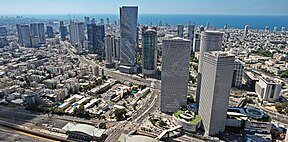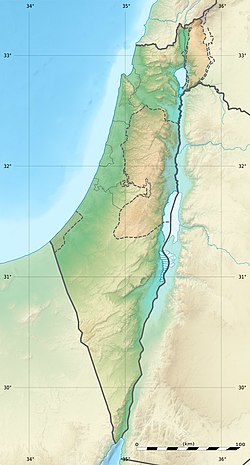
Back Tel Aviv Afrikaans Tel Aviv-Jaffa ALS ቴል አቪቭ Amharic Telfafif ANG تل أبيب Arabic ܬܠ ܐܒܝܒ ARC تل أبيب ARY تل ابيب ARZ Tel Aviv AST तेल अभिभ AWA
Tel Aviv
| |
|---|---|
| Tel Aviv-Yafo | |
Nicknames:
| |
| Coordinates: 32°05′N 34°47′E / 32.08°N 34.78°E | |
| Country | |
| District | |
| Metropolitan area | Gush Dan |
| Founded | 11 April 1909 |
| Named for | Tel Abib in Ezekiel 3:15,[1] via Herzl's Altneuland |
| Government | |
| • Type | Mayor–council |
| • Body | Tel Aviv-Yafo Municipality |
| • Mayor | Ron Huldai |
| Area | |
| • City | 52 km2 (20 sq mi) |
| • Urban | 176 km2 (68 sq mi) |
| • Metro | 1,516 km2 (585 sq mi) |
| Elevation | 5 m (16 ft) |
| Population (2022)[2] | |
| • City | 474,530 |
| • Rank | 2nd in Israel |
| • Density | 8,468.7/km2 (21,934/sq mi) |
| • Rank | 12th in Israel |
| • Urban | 1,388,400 |
| • Urban density | 8,057.7/km2 (20,869/sq mi) |
| • Metro | 4,156,900 |
| • Metro density | 2,286/km2 (5,920/sq mi) |
| Demonym | Tel Avivian[3][4][5] |
| Gross Metropolitan Product | |
| • Gush Dan | US$310 billion 59% of Israel's GDP (2022) |
| Time zone | UTC+2 (IST) |
| • Summer (DST) | UTC+3 (IDT) |
| Postal code | 61XXXXX |
| Area code | +972-3 |
| ISO 3166 code | IL-TA |
| Website | tel-aviv.gov.il |
| Official name | White City of Tel Aviv |
| Type | Cultural |
| Criteria | ii, iv |
| Designated | 2003 |
| Reference no. | [1] |
| Region | Israel |
|
Preview warning: Page using Template:Infobox designation list with unknown parameter "designation1_meaning of n..." | |
Tel Aviv-Yafo (Hebrew: תֵּל אָבִיב-יָפוֹ, romanized: Tēl ʾĀvīv-Yāfō, IPA: [tel aˈviv jaˈfo]; Arabic: تَلّ أَبِيب – يَافَا, romanized: Tall ʾAbīb-Yāfā), usually referred to as just Tel Aviv, is the most populous city in the Gush Dan metropolitan area of Israel. Located on the Israeli Mediterranean coastline and with a population of 474,530, it is the economic and technological center of the country. If East Jerusalem is considered part of Israel, Tel Aviv is the country's second-most-populous city, after Jerusalem; if not, Tel Aviv is the most populous city, ahead of West Jerusalem.[a]
Tel Aviv is governed by the Tel Aviv-Yafo Municipality, headed by Mayor Ron Huldai, and is home to most of Israel's foreign embassies.[b] It is a beta+ world city and is ranked 57th in the 2022 Global Financial Centres Index. Tel Aviv has the third- or fourth-largest economy and the largest economy per capita in the Middle East.[11][12] The city currently has the highest cost of living in the world.[13][14] Tel Aviv receives over 2.5 million international visitors annually.[15][16] A "party capital" in the Middle East, it has a lively nightlife and 24-hour culture.[17][18] The city is gay-friendly, with a large LGBT community.[19] Tel Aviv is home to Tel Aviv University, the largest university in the country with more than 30,000 students.
The city was founded in 1909 by the Yishuv (Jewish residents) and initially given the Hebrew name Ahuzat Bayit (Hebrew: אחוזת בית, romanized: ʔAħuzat Bayit, lit. 'House Estate' or 'Homestead'),[20][21] namesake of the Jewish association which established the neighbourhood as a modern housing estate on the outskirts of the ancient port city of Jaffa (Yafo in Hebrew), then part of the Mutasarrifate of Jerusalem within the Ottoman Empire. Its name was changed the following year to Tel Aviv, after the biblical name Tel Abib (lit. "Tell of Spring") adopted by Nahum Sokolow as the title for his Hebrew translation of Theodor Herzl's 1902 novel Altneuland ("Old New Land"). Other Jewish suburbs of Jaffa had been established before Tel Aviv, the oldest among them being Neve Tzedek.[22] Tel Aviv was given township status within the Jaffa Municipality in 1921, and became independent from Jaffa in 1934.[23][24] Immigration by mostly Jewish refugees meant that the growth of Tel Aviv soon outpaced that of Jaffa, which had a majority Arab population at the time.[25] In 1948 the Israeli Declaration of Independence was proclaimed in the city. After the 1947–1949 Palestine war, Tel Aviv began the municipal annexation of parts of Jaffa, fully unified with Jaffa under the name Tel Aviv in April 1950, and was formally renamed to Tel Aviv-Yafo in August 1950.[26]
Tel Aviv's White City, designated a UNESCO World Heritage Site in 2003, comprises the world's largest concentration of International Style buildings, including Bauhaus and other related modernist architectural styles.[27][28] Popular attractions include Jaffa Old City, the Eretz Israel Museum, the Museum of Art, Hayarkon Park, and the city's promenade and beach.
- ^ Ezekiel 3:15
- ^ "Regional Statistics". Israel Central Bureau of Statistics. Retrieved 21 March 2024.
- ^ Azaryahu, Maoz (2007). Tel Aviv: Mythography of a City. Syracuse, New York: Syracuse University Press. pp. 133–134. ISBN 978-0-8156-3129-3.
- ^ Mann, Barbara E. (2006). A Place in History: Modernism, Tel Aviv, and the Creation of Jewish Urban Space. Stanford, California: Stanford University Press. pp. 148, 166. ISBN 978-0-8047-5019-6.
- ^ The Cities Book: A Journey Through the Best Cities in the World. Melbourne, Oakland and London: Lonely Planet. 2009. pp. 380–381. ISBN 978-1-74179-887-6.
- ^ "Instead of talking about national economy, we should talk about cities". calcalist.co.il. Archived from the original on 12 November 2023. Retrieved 12 November 2023.
- ^ "World Economic Outlook database: October 2023". imf.org. Archived from the original on 12 November 2023. Retrieved 12 November 2023.
- ^ Korach, Michal; Choshen, Maya. Jerusalem Facts and Trends 2019 (PDF). Jerusalem Institute for Policy Research. p. 14. Archived (PDF) from the original on 2 July 2019. Retrieved 8 July 2019.
- ^ "Map of Israel" (PDF). Archived (PDF) from the original on 1 June 2020. Retrieved 29 June 2017. (319 KB)
- ^ "Israel". CIA World Factbook. 21 June 2022. Archived from the original on 13 September 2021. Retrieved 24 January 2021.
- ^ "Global Financial Centres Index #23" (PDF). longfinance.net. 22 August 2018. Archived (PDF) from the original on 17 June 2022. Retrieved 22 August 2018.
- ^ "Global city GDP 2014". Brookings Institution. 22 January 2015. Archived from the original on 7 January 2019. Retrieved 8 May 2015.
- ^ "Tel Aviv named as world's most expensive city to live in". BBC. 1 December 2021. Archived from the original on 14 January 2022. Retrieved 24 January 2022.
- ^ McKeever, Vicky (1 December 2021). "This is now the world's most expensive city to live in, study says". CNBC. Archived from the original on 24 January 2022. Retrieved 24 January 2022.
- ^ Goldman, Yoel (12 June 2012). "MasterCard ranks Tel Aviv as fifth most visited city in Middle East and Africa". The Times of Israel. Archived from the original on 15 June 2012. Retrieved 12 June 2012.
- ^ Sapty, Tanya (19 July 2011). "Tourists rank Jerusalem and Tel Aviv among top cities to visit". Haaretz. Archived from the original on 12 November 2011.
- ^ "The world's top 10 party towns". The Sydney Morning Herald. 19 November 2009. Archived from the original on 10 April 2010. Retrieved 20 February 2020.
- ^ "Lonely Planet's top 10 cities for 2011". Archived from the original on 3 November 2010. Retrieved 31 October 2010.
- ^ Cite error: The named reference
Burdenwas invoked but never defined (see the help page). - ^ "Today in history: Founding of Tel Aviv – Christian News – Jerusalem Post". The Jerusalem Post. 11 April 2016. Archived from the original on 14 November 2018. Retrieved 22 May 2019.
- ^ Dvir, Noam (Dabul) (27 July 2015). "The promised landfill: 106 years of garbage in Tel Aviv". Ynetnews. Archived from the original on 23 May 2020. Retrieved 22 May 2019.
- ^ Elkayam, Mordechai (1990). Yafo – Neve-Tzedek, Rashita shel Tel-Aviv (in Hebrew). Ministry of Defence. p. 199.
- ^ Goren, Tamir (2016). "Tel Aviv and the question of separation from Jaffa 1921–1936". Middle Eastern Studies. 52 (3): 473–487. doi:10.1080/00263206.2015.1125340. S2CID 147012425.
Page 1: "Once Tel Aviv had won municipal status (the so-called Tel Aviv Township) in 1921, it strove to amend the relevant legislation by rescission of the clauses that placed it under Jaffa municipality's supervision. In the succeeding years, this question became increasingly to the fore, and demanded a speedy solution. Together with the Tel Aviv's ambition of independence as a Hebrew city with its own autonomous Hebrew government, some members of the township's council did not favour separation from the mother city Jaffa. In the mid-1920s, the view consoli- dated among the town councillors that Tel Aviv's subjection to Jaffa municipality had to be annulled, and it must be granted its deserved status as an independent Hebrew city."
Page 3: "Tel Aviv municipality strove for full municipal rights, for the status of a municipality with all its implications, in this way enjoying absolute independence. Yet it still wished to maintain its interests in Jaffa. Most obvious was the desire not to lose the Jewish influence in the Jaffa municipality, as well as reinforcing the clout of the Jews on the municipal council. In Tel Aviv's view, Jaffa enjoyed important status not only locally. At that time it was second in importance in Palestine only to Jerusalem, and was followed by Haifa, Safed and Tiberias."
Page 4: "...the Mandate government took a positive view of Tel Aviv's desire for full municipal independence. But at that stage it refrained from making any changes at all in Tel Aviv's municipal status. From the closing years of the 1920s, the authorities immersed themselves in the preparation of a new framework for the Municipalities Law, which was intended to replace the Ottoman law. So as long as the new law was incomplete, the authorities avoided any change in the municipal status of Tel Aviv. [Footnote: The new Municipalities Order was published in 1934. That year Tel Aviv gained full municipal independence, becoming a municipal corporation.]" - ^ M. Gorion (Wager), Introduction to the History of Local Government in Israel (Jerusalem: University of Tel Aviv, 1957), pp.184–5 [Hebrew].
- ^ 85% in 1922, 92% in 1931 (Census reports)
- ^ Cite error: The named reference
Golan1995was invoked but never defined (see the help page). - ^ "The White City of Tel Aviv" (PDF). UNESCO. Archived from the original (PDF) on 9 April 2008. Retrieved 29 March 2008.
- ^ Strimpel, Zoe (16 February 2008). "Hip and happening in Tel Aviv". The Times. London. Archived from the original on 19 July 2008.
Cite error: There are <ref group=lower-alpha> tags or {{efn}} templates on this page, but the references will not show without a {{reflist|group=lower-alpha}} template or {{notelist}} template (see the help page).
© MMXXIII Rich X Search. We shall prevail. All rights reserved. Rich X Search












